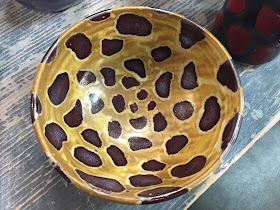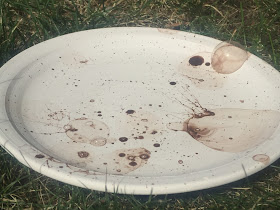One of the most surprising things about the
workshop I took in Montana, a workshop ostensibly focused on the form of functional pottery, was that we spent the first day and half glazing.
 |
| my glazed work from the workshop |
The idea was to think hard about glaze so that we will be thinking about glaze later when we are making work. Many potters tend to think of form first and forget about surface. Talk to pottery students and sculptors alike and many, myself included, will prefer, or at least appreciate the look of leather-hard work, before it has dried, before it has been fired, before glazing.
For someone who is focused on the making of the work, the glazing can feel like an afterthought, or a tedious chore that needs to be done but isn't fun. I wholeheartedly agree that
I'd rather not go through the process of applying glaze at all, even though I like the end-result of a glazed piece.
Glazing is an essential part of most pottery.
Peter Beasecker, our workshop instructor, started the workshop by showing images of different pottery pieces and discussing the glaze application rather than the form--or, more accurately, he discussed how the form and the glaze worked together. He showed drippy glazes, layered glazes, matte glazes juxtaposed with high gloss glazes, and complex painted, carved and resist decorations.
 |
| one of my bowls with latex partially applied |
Our first assignment was to draw on our bisque ware, identifying places we could use liquid latex to resist glaze application. After applying latex to these marked areas, we dipped our bisque ware in glaze, peeled off the resist and reapplied the latex over the glazed sections to resist the second application of glaze.
 |
| one of my pieces with a layer of latex (around the rim and the cloud shapes) on top of the just-applied glaze |
I've used latex before with little success, but I suspect I used an inferior brand. When I used it at home, it didn't peel off or took all the glaze off with it. The latex we used at the workshop worked well without much hassle. The instructor dyed the latex with food coloring so it would be more visible (green) and it was fairly easy to use--stinky as all get-out, but easy to use.
one of my mugs with latex resist (left) and glazed with latex removed (right)
The process of using latex was very different from how I usually glaze. For my functional work at school, I usually use a minimal-effort combination of dipping and dripping. I rarely plan my glazes before I start to apply them and often use whatever glaze happens to be open. (Students, if you're reading this, don't do as I do.) Of course, this works mostly because I'm making fairly simple work, I don't usually have much time to glaze, and I know the studio glazes fairly well.
 |
| the dipped and dripped glazing I do in the YVCC studio (the pitcher used a tape circle to resist underglaze) |
At home I tend to use
layers of underglaze, but on highly textured sculpture. With my functional work I have been experimenting with
tape resist recently, but the results have been mixed.
 |
| A cup by Andrew Gilliatt (among the studio coffee mugs) illustrates a beautiful use of a thick white glaze over a matte blue. The clouds are thicker at the bottom, their dimensionality contrasting with the flat bird decals. |
The great thing about taking a workshop at the
Archie Bray Foundation is that there are lots and lots of example pieces to look at while working. In the studio classroom, the mugs for coffee and tea were done by artists who had residencies at the Bray. It was helpful to look at the glazing done by other artists when planning the surfaces of our own pieces.
 |
| This piece was just dipped; the dark colored areas have latex resist which is causing the glaze to dry more slowly. |
I didn't take advantage of the movement of the glazes in my own work, in part because I didn't apply the glazes very thickly. Mostly my glazes stayed where I put them in this batch of work. However, the discussion of how the form interacts with the glaze was valuable and I can see how a form could be made to fit a runny glaze, a la
Doug Peltzman. I can see how introducing glazing early on, and in a considered way, could be useful for my students.
 |
| some of my work with one or two layers of glaze and some green latex |
I spent Monday afternoon and most of Tuesday morning "glazing". Most of the time was actually spent applying or removing latex. We loaded the kiln Wednesday and unloaded it on Thursday. The Bray has a
Blaauw kiln, which circulates the heat with a blower system and can be fired more quickly than "normal" kilns.
 |
| one of my bowls after firing |
I was mostly pleased with the results of my glazing, though I could have applied the glaze more thickly in most cases. The glazes are similar to those we have in the YVCC studio, meaning I could anticipate how they would look. I did bisque the work to cone 04, which means the pieces were a bit less porous than usual. This or and excess of caution was the reason my application was light.
 |
| My favorite piece from the workshop, I used latex to block out the shapes, then dipped in a matte black glaze. I then peeled away the latex, reapplied latex over the black glaze and dipped a second time in oxblood red. The reduction in the kiln was surprisingly even, given the size of the load. |
The glazes were not similar to the glazes I have at home and I will have to try new glazes if I am fire the rest of the bisque ware from the workshop to cone 6. The instructor offered an interesting suggestion for glazing in a small studio with limited glaze options. He suggested planning one's glaze around a black and a white or clear, with one other color. It is a useful way to think about choosing glazes and a nice way to build a glaze repertoire without trying to have every color option available.
 |
| A mug by Sunshine Cobb (in the Pottery classroom) doesn't use runny glaze or resist . |
In general I found the latex to be interesting and useful for some applications, but stinky and tedious. Partway through the glazing process I decided to play with a tool I've always called a
slip trailer, but instead of using it for slip application, I used it for glaze. I applied the glaze in lines directly on the bisque ware or on top of a layer of glaze.
 |
| one of my mugs before firing (no resist used here) |
I mostly skipped the latex at this point, using it only to keep the clear glaze off the dots of color. This method was significantly faster and the results seemed good.
 |
| I do not know the artist for this mug found in the pottery classroom. |
I didn't realize until after I had started using this technique that one of the mugs in the studio had a similar design on its surface, probably done using similar techniques to mine. I'm guessing I saw it early on and it inspired my approach, but I didn't consciously notice it until I was done.
 |
| The pieces on the left have clear glaze applied over the black glaze lines, but resist was used for the colored circles. |
Now that I am home from the workshop, I have quite a bit of work to glaze. I bought some new glazes for cone 06, though I've never actually tested my kiln at that temperature. I brought home a respectable amount of bisque ware made with cone 6 clay. I also have some pieces I made with
low fire clay before the workshop. I plan to finish both sets of functional work in the next few weeks.
 |
| My mugs after firing: the center piece has black glaze applied over another glaze, the others have clear glaze applied over the black. |



















































